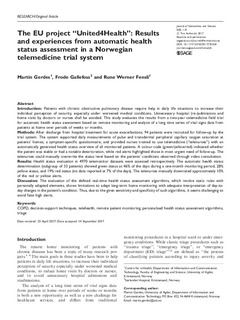| dc.contributor.author | Gerdes, Martin | |
| dc.contributor.author | Gallefoss, Frode | |
| dc.contributor.author | Fensli, Rune Werner | |
| dc.date.accessioned | 2018-03-20T11:32:07Z | |
| dc.date.available | 2018-03-20T11:32:07Z | |
| dc.date.created | 2017-10-11T16:42:31Z | |
| dc.date.issued | 2017 | |
| dc.identifier.citation | Journal of Telemedicine and Telecare. 2017, . | nb_NO |
| dc.identifier.issn | 1357-633X | |
| dc.identifier.uri | http://hdl.handle.net/11250/2491230 | |
| dc.description.abstract | Introduction Patients with chronic obstructive pulmonary disease require help in daily life situations to increase their individual perception of security, especially under worsened medical conditions. Unnecessary hospital (re-)admissions and home visits by doctors or nurses shall be avoided. This study evaluates the results from a two-year telemedicine field trial for automatic health status assessment based on remote monitoring and analysis of a long time series of vital signs data from patients at home over periods of weeks or months. Methods After discharge from hospital treatment for acute exacerbations, 94 patients were recruited for follow-up by the trial system. The system supported daily measurements of pulse and transdermal peripheral capillary oxygen saturation at patients' homes, a symptom-specific questionnaire, and provided nurses trained to use telemedicine ("telenurses") with an automatically generated health status overview of all monitored patients. A colour code (green/yellow/red) indicated whether the patient was stable or had a notable deterioration, while red alerts highlighted those in most urgent need of follow-up. The telenurses could manually overwrite the status level based on the patients' conditions observed through video consultation. Results Health status evaluation in 4970 telemonitor datasets were assessed retrospectively. The automatic health status determination (subgroup of 33 patients) showed green status at 46% of the days during a one-month monitoring period, 28% yellow status, and 19% red status (no data reported at 7% of the days). The telenurses manually downrated approximately 10% of the red or yellow alerts. Discussion The evaluation of the defined real-time health status assessment algorithms, which involve static rules with personally adapted elements, shows limitations to adapt long-term home monitoring with adequate interpretation of day-to-day changes in the patient's condition. Thus, due to the given sensitivity and specificity of such algorithms, it seems challenging to avoid false high alerts. | nb_NO |
| dc.language.iso | eng | nb_NO |
| dc.publisher | Sage | nb_NO |
| dc.title | The EU project “United4Health”: Results and experiences from automatic health status assessment in a Norwegian telemedicine trial system | nb_NO |
| dc.type | Journal article | nb_NO |
| dc.type | Peer reviewed | nb_NO |
| dc.description.version | acceptedVersion | nb_NO |
| dc.source.pagenumber | 8 | nb_NO |
| dc.source.journal | Journal of Telemedicine and Telecare | nb_NO |
| dc.identifier.doi | 10.1177/1357633X17735558 | |
| dc.identifier.cristin | 1503909 | |
| dc.relation.project | EC/FP7/CIP-ICT PSP-2012-3 | nb_NO |
| dc.relation.project | Norges forskningsråd: 227131 | nb_NO |
| dc.description.localcode | nivå1 | nb_NO |
| cristin.unitcode | 201,15,4,0 | |
| cristin.unitname | Institutt for informasjons- og kommunikasjonsteknologi | |
| cristin.ispublished | true | |
| cristin.fulltext | postprint | |
| cristin.qualitycode | 1 | |
